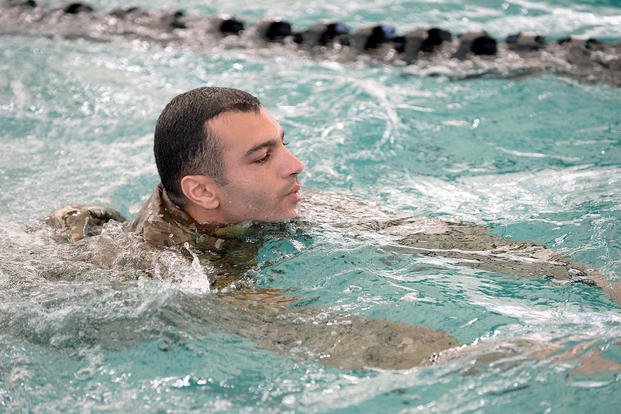People of all shapes, sizes and backgrounds join the military each year. Many are great swimmers, most are average swimmers and some cannot swim at all. Here is an interesting question that prompted a longer explanation in order to accurately answer this question: "How good of a swimmer should you be?"
"Stew, I am a three-sport athlete about to finish high school, but not a great swimmer. I can swim, but having issues with reaching the faster times Navy Spec War (SEAL) recommends on the BUD/S PST. I am heading to college to likely focus on football and track, but would like to be able to go to BUD/S and become a SEAL after I graduate (either enlist or OCS). How important is getting the 500-yard swim time down to 8 minutes vs. maybe 9 minutes and being comfortable in the water?
First, congrats on soon becoming a collegiate athlete. I tell people all the time, learning to be a team player (in something) is one of the most critical skills you need if you want to join the SEAL teams or the military in general. You will be a part of a team when you serve; being a good team player will help you tremendously. You could even say it is more important than swimming, but you still need to swim (and swim well).
While it is true the Navy recommends you to have an above-average swimming ability, it by no means requires you to be a world-class swimmer. These recommended standards are not that tough to get, even for non-swimming athletes as yourself.
I will say that as a powerlifting, football player, you likely will swim better with fins than without fins. I have seen so many big, strong-legged athletes barely pass the 500-yard swim, but put on a pair of SCUBA fins and be in the top-five swim pairs in the class.
It is true you should be at least in the eight- to nine-minute time zone on the 500-yard BUD/S PST swim to get to training, but when you get to BUD/S, you will be swimming with fins 99% of the time to get through training. These swims are in the form of two- to five-mile ocean swims each week, progressing throughout the three phases of BUD/S.
But to get better at the timed swim without fins, focus on your technique for the next few years. See swim videos to help teach you and get in the water as often as you can. The key is becoming comfortable in the water.
This is an absolute must. It is far more important for you to be comfortable in the water, underwater and in dark, open ocean water, either swimming or on SCUBA, than swimming a sub-eight-minute, 500-yard swim. You will be tied (feet/hand behind your back) during the drownproofing test and required to perform a variety of skills. See related article.
You will be required to learn how to SCUBA dive at BUD/S and perform dives at night navigating underwater in Navy ports, under ships. But if you can swim a sub-eight-minute, 500-yard swim, it will not go to waste as you will hear many times, "It pays to be a winner."
Being the fastest swimmer, runner, on the obstacle course or best PTer is never a bad thing, and you will not be the best at all of them. You will have weaknesses in something at BUD/S. That is the beauty of the training; it exposes your weaknesses. So work on your swimming now if you know it is a weakness. It does not have to be pretty, but it must be effective.
Not knowing how to swim is a potentially dangerous situation waiting to happen and will make you ineffective on 75% of Earth, not only as a military member but as a human. Learning the basics on floating and moving across a pool is a great start so you at least will survive if you fell into the water deeper than your height.
Get lessons. Watch online video instruction of people swimming and teaching swimming and practice in the shallow end of a pool. Swimming is a basic survival skill that we all need not only to save ourselves, but to save others important to us as well.
I know as a former football player and track guy, I once thought anything more than 100 yards was long distance. BUD/S is a running intensive program. You will run everywhere you go, accumulating 5-6 miles just going to and from the chow hall each day.
Add in four-mile timed runs and a few five- to six-mile beach runs each week, and you will have about 40-45 miles of weekly running. Making your BUD/S prep not interfere with your football and track workouts will be the challenge, but you will need to add in some longer-distance runs at least during the offseason. A good goal is 9-9:30 or faster for the 1.5-mile run and under 28 minutes for four-mile timed runs.
Have fun the next few years building a solid foundation of physical and mental toughness as well as developing your teamwork and leadership abilities. Enjoy the journey.
Stew Smith is a former Navy SEAL and fitness author certified as a Strength and Conditioning Specialist (CSCS) with the National Strength and Conditioning Association. Visit his Fitness eBook store if you're looking to start a workout program to create a healthy lifestyle. Send your fitness questions to stew@stewsmith.com.
Want to Learn More About Military Life?
Whether you're thinking of joining the military, looking for fitness and basic training tips, or keeping up with military life and benefits, Military.com has you covered. Subscribe to Military.com to have military news, updates and resources delivered directly to your inbox.



















